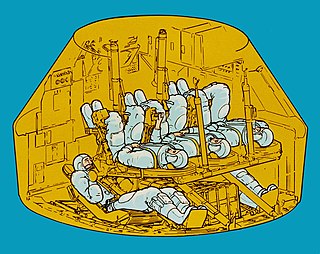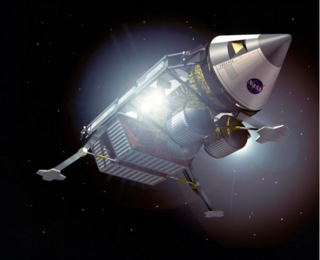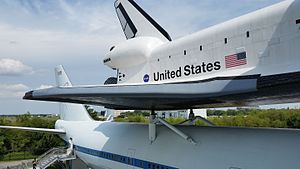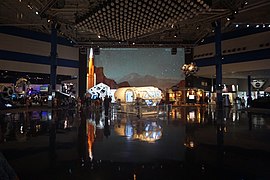
The Apollo program, also known as Project Apollo, was the United States human spaceflight program carried out by the National Aeronautics and Space Administration (NASA), which succeeded in preparing and landing the first men on the Moon from 1968 to 1972. It was first conceived in 1960 during President Dwight D. Eisenhower's administration as a three-person spacecraft to follow the one-person Project Mercury, which put the first Americans in space. Apollo was later dedicated to President John F. Kennedy's national goal for the 1960s of "landing a man on the Moon and returning him safely to the Earth" in an address to Congress on May 25, 1961. It was the third US human spaceflight program to fly, preceded by the two-person Project Gemini conceived in 1961 to extend spaceflight capability in support of Apollo.

The John F. Kennedy Space Center, located on Merritt Island, Florida, is one of the National Aeronautics and Space Administration's (NASA) ten field centers. Since December 1968, KSC has been NASA's primary launch center of American spaceflight, research, and technology. Launch operations for the Apollo, Skylab and Space Shuttle programs were carried out from Kennedy Space Center Launch Complex 39 and managed by KSC. Located on the east coast of Florida, KSC is adjacent to Cape Canaveral Space Force Station (CCSFS). The management of the two entities work very closely together, share resources and operate facilities on each other's property.

Skylab was the United States' first space station, launched by NASA, occupied for about 24 weeks between May 1973 and February 1974. It was operated by three trios of astronaut crews: Skylab 2, Skylab 3, and Skylab 4. Operations included an orbital workshop, a solar observatory, Earth observation and hundreds of experiments. Skylab's orbit eventually decayed and it disintegrated in the atmosphere on July 11, 1979, scattering debris across the Indian Ocean and Western Australia.

The Constellation program was a crewed spaceflight program developed by NASA, the space agency of the United States, from 2005 to 2009. The major goals of the program were "completion of the International Space Station" and a "return to the Moon no later than 2020" with a crewed flight to the planet Mars as the ultimate goal. The program's logo reflected the three stages of the program: the Earth (ISS), the Moon, and finally Mars—while the Mars goal also found expression in the name given to the program's booster rockets: Ares. The technological aims of the program included the regaining of significant astronaut experience beyond low Earth orbit and the development of technologies necessary to enable sustained human presence on other planetary bodies.

The Saturn IB(also known as the uprated Saturn I) was an American launch vehicle commissioned by the National Aeronautics and Space Administration (NASA) for the Apollo program. It uprated the Saturn I by replacing the S-IV second stage, with the S-IVB. The S-IB first stage also increased the S-I baseline's thrust from 1,500,000 pounds-force (6,700,000 N) to 1,600,000 pounds-force (7,100,000 N) and propellant load by 3.1%. This increased the Saturn I's low Earth orbit payload capability from 20,000 pounds (9,100 kg) to 46,000 pounds (21,000 kg), enough for early flight tests of a half-fueled Apollo command and service module (CSM) or a fully fueled Apollo Lunar Module (LM), before the larger Saturn V needed for lunar flight was ready.

The Skylab Rescue Mission was an unflown rescue mission, planned as a contingency in the event of astronauts being stranded aboard the American Skylab space station. If flown, it would have used a modified Apollo Command Module that could be launched with a crew of two and return a crew of five.

The Apollo command and service module (CSM) was one of two principal components of the United States Apollo spacecraft, used for the Apollo program, which landed astronauts on the Moon between 1969 and 1972. The CSM functioned as a mother ship, which carried a crew of three astronauts and the second Apollo spacecraft, the Apollo Lunar Module, to lunar orbit, and brought the astronauts back to Earth. It consisted of two parts: the conical command module, a cabin that housed the crew and carried equipment needed for atmospheric reentry and splashdown; and the cylindrical service module which provided propulsion, electrical power and storage for various consumables required during a mission. An umbilical connection transferred power and consumables between the two modules. Just before reentry of the command module on the return home, the umbilical connection was severed and the service module was cast off and allowed to burn up in the atmosphere.

Project Gemini was the second United States human spaceflight program to fly. Conducted after the first American manned space program, Project Mercury, while the Apollo program was still in early development, Gemini was conceived in 1961 and concluded in 1966. The Gemini spacecraft carried a two-astronaut crew. Ten Gemini crews and 16 individual astronauts flew low Earth orbit (LEO) missions during 1965 and 1966.
The Apollo Applications Program (AAP) was created as early as 1966 by NASA headquarters to develop science-based human spaceflight missions using hardware developed for the Apollo program. AAP was the ultimate development of a number of official and unofficial Apollo follow-on projects studied at various NASA labs. However, the AAP's ambitious initial plans became an early casualty when the Johnson Administration declined to support it adequately, partly in order to implement its Great Society set of domestic programs while remaining within a $100 billion budget. Thus, Fiscal Year 1967 ultimately allocated $80 million to the AAP, compared to NASA's preliminary estimates of $450 million necessary to fund a full-scale AAP program for that year, with over $1 billion being required for FY 1968. The AAP eventually led to Skylab, which absorbed much of what had been developed under Apollo Applications.

Voyage is a 1996 hard science fiction novel by British author Stephen Baxter. The book depicts a crewed mission to Mars as it might have been in another timeline, one where John F. Kennedy survived the assassination attempt on him on 22 November 1963. Voyage won a Sidewise Award for Alternate History, and was nominated for the Arthur C. Clarke Award in 1997.

The Space Transportation System (STS), also known internally to NASA as the Integrated Program Plan (IPP), was a proposed system of reusable crewed space vehicles envisioned in 1969 to support extended operations beyond the Apollo program. The purpose of the system was two-fold: to reduce the cost of spaceflight by replacing the current method of launching capsules on expendable rockets with reusable spacecraft; and to support ambitious follow-on programs including permanent orbiting space stations around Earth and the Moon, and a human landing mission to Mars.

The Kennedy Space Center Visitor Complex is the visitor center at NASA's Kennedy Space Center on Merritt Island, Florida. It features exhibits and displays, historic spacecraft and memorabilia, shows, two IMAX theaters, and a range of bus tours of the spaceport. The "Space Shuttle Atlantis" exhibit contains the Atlantis orbiter and the Shuttle Launch Experience, a simulated ride into space. The center also provides astronaut training experiences, including a multi-axial chair and Mars Base simulator. The visitor complex also has daily presentations from a veteran NASA astronaut. A bus tour, included with admission, encompasses the separate Apollo/Saturn V Center. There were 1.7 million visitors to the visitor complex in 2016.
Several planned missions of the Apollo crewed Moon landing program of the 1960s and 1970s were canceled, for reasons which included changes in technical direction, the Apollo 1 fire, hardware delays, and budget limitations. After the landing by Apollo 12, Apollo 20, which would have been the final crewed mission to the Moon, was canceled to allow Skylab to launch as a "dry workshop". The next two missions, Apollos 18 and 19, were later canceled after the Apollo 13 incident and further budget cuts. Two Skylab missions also ended up being canceled. Two complete Saturn V rockets remained unused and were put on display in the United States.

A boilerplate spacecraft, also known as a mass simulator, is a nonfunctional craft or payload that is used to test various configurations and basic size, load, and handling characteristics of rocket launch vehicles. It is far less expensive to build multiple, full-scale, non-functional boilerplate spacecraft than it is to develop the full system. In this way, boilerplate spacecraft allow components and aspects of cutting-edge aerospace projects to be tested while detailed contracts for the final project are being negotiated. These tests may be used to develop procedures for mating a spacecraft to its launch vehicle, emergency access and egress, maintenance support activities, and various transportation processes.

Skylab B was a proposed second US space station similar to Skylab that was planned to be launched by NASA for different purposes, mostly involving the Apollo–Soyuz Test Project, but was canceled due to lack of funding. Two Skylab modules were built in 1970 by McDonnell Douglas for the Skylab program, originally the Apollo Applications Program. The first was launched in 1973 and the other put in storage, while NASA considered how to use the remaining assets from Apollo.

The Saturn V is a retired American super heavy-lift launch vehicle developed by NASA under the Apollo program for human exploration of the Moon. The rocket was human-rated, had three stages, and was powered by liquid fuel. Flown from 1967 to 1973, it was used for nine crewed flights to the Moon, and to launch Skylab, the first American space station.
With the advent of robotic and human spaceflight a new era of American history had presented itself. Keeping with the tradition of honoring the country's history on U.S. postage stamps, the U.S. Post Office began commemorating the various events with its commemorative postage stamp issues. The first U.S. Postage issue to depict a U.S. space vehicle was issued in 1948, the Fort Bliss issue. The first issue to commemorate a space project by name was the ECHO I communications satellite commemorative issue of 1960. Next was the Project Mercury issue of 1962. As U.S. space exploration progressed a variety of other commemorative issues followed, many of which bear accurate depictions of satellites, space capsules, Apollo Lunar Modules, space suits, and other items of interest.

The retirement of NASA's Space Shuttle fleet took place from March to July 2011. Discovery was the first of the three active Space Shuttles to be retired, completing its final mission on March 9, 2011; Endeavour did so on June 1. The final shuttle mission was completed with the landing of Atlantis on July 21, 2011, closing the 30-year Space Shuttle program.

The International Lunar Resources Exploration Concept (ILREC) was a proposed mission architecture under President George H. W. Bush's Space Exploration Initiative (SEI) by Kent Joosten, an engineer at Johnson Space Center. The plan would have used the help of international partners, mainly the Soviet Union, to assemble a lunar base and sustainable lunar transportation service.




























